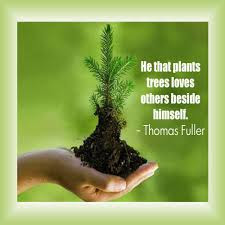There is a frequently quoted Chinese proverb that states that the best time to plant a tree is 20 years ago and the next best time is now. There is a lot of truth to that. We who garden for the rest of life do so understanding that the fruits of our labor will increase in future years and that what we do now is only a beginning. I may well never sit under the shade of my developing deciduous woodland, but I can see it in my mind's eye. I envision what it will look like; the basswood arching up and over the rest of my understory trees and shrubs, the various hawthorns, silverbells, serviceberries, bumelias, azaleas and viburnums awash in spring flowers before their fruit form beneath the canopy, the songbirds darting in and out of this collection of plants finding food and nesting cover. I envision it though I may well not ever see it during my lifetime. In addition to the age I now find myself to be, this is a rental home and I am not really in control of this home and its landscape. None of this matters to me, however. The gifts that have been given me in life require me to pay them forward. We do not really receive gifts that are free. For each we accept, we take on a responsibility to pay something back of at least an equal value. I garden here for myself. That is true as I get so much out of it, but I also garden because I understand the responsibility I have to the rest of the living world for the gifts it has provided me during all of these years. As I putter about my developing woodland, I can already see some of the changes my work has fostered. A few of my small trees produced flowers this past spring and early summer, but they are still too immature to have carried them to term. My arrowwood viburnum (V. dentatum), however, is now covered in clusters of white flowers and I have hope that at least some of them will result in the dark purple fruit my songbirds will relish. The rusty viburnum (V. rufidulum) should bloom later and it too may produce fruit for the cardinals and mockingbirds that now share this landscape with me. The trees and shrubs I've added are also part of my pollinator landscape scheme. Without the pollinators, they won't produce the fruit my wildlife require if they are to live with me. All parts of the living world are intrinsically tied together. There really is no such thing as a "pollinator garden" that excludes trees and shrubs. Of course, my wildflower meadow creates the conditions that succor the bees, butterflies, and other pollinators that I am creating living conditions for. To that extent, I have recently tied the front and back yard plantings together by adding wildflowers to the edge of my woodland. By adding them to the sunny southern edge, they will get the sunlight they need even as the trees gain girth and height. The asters will spread out from this edge and find the sunny holes in the canopy to the interior as well. The shade-tolerant species, like the lyre-leaved salvia (S. lyrata) and the giant ironweed (Vernonia gigantea), are already finding the conditions they are best adapted to. Planting a community of plants to create a living landscape requires a vision - the ability to look into the future and see what it should become, the patience to wait for it to develop, and the generosity to give this landscape (without strings attached) to the rest of the living world. We pay it forward. |





This is a beautiful post - and I can hear the echoes of Kimmerer's "Braiding Sweetgrass" in your comments about paying forward to the living world in reciprocity for the gifts we have received. Here in east central Florida (Volusia County), on a suburban lot (that, thank goodness, we do own), we are now working on plans for restoring habitat to a big section that we had to have cleared (a tangle of old vines and trees that were storm hazards to our own and neighboring houses). Your books and blogs are our guides. "There Were No Fences" has been, and continues to be, an inspiration to us on this journey - especially since we are also "the age" we find ourselves to be. Thank you.
ReplyDelete